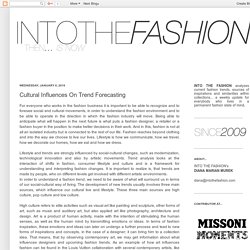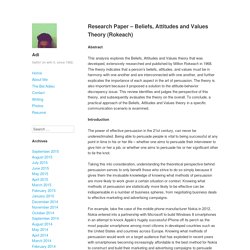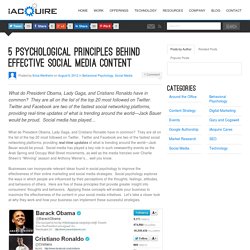

INTO THE FASHION: Cultural Influences On Trend Forecasting. For everyone who works in the fashion business it is important to be able to recognize and to foresee social and cultural movements, in order to understand the fashion environment and to be able to operate in the direction in which the fashion industry will move.

Being able to anticipate what will happen in the next future is what puts a fashion designer, a retailer or a fashion buyer in the position to make better decisions in their work. Interbrand cg retail cx wp 2400662. Segment12. Being Stylish. Many of our readers e-mail us with specific fashion questions such as: "How do I know whether or not I'm fashionable?

" or "How can I become more trendy? " From normcore to chaos magic: the people behind fashion's biggest buzzwords. This month, the curious concept of normcore is celebrating its second birthday.

That’s two years of North Face and Chaps, of wanging on about Larry David and your dad’s fleece, and of the many shades of navy, beige and blah now writ large in your wardrobe. We say celebrating, but in truth, the portmanteau of “normal” and “hardcore” that describes a certain unspecial, brandless, 1990s-referencing look has become a bit of a hate word. Partly because it’s seen an anti-trend, but partly because people have been dressing like this for years and it’s only since it was “adopted” by a new generation that it became a talking point. The mixed reaction isn’t the fault of the US “trend forecasting” agency/art collective K-Hole, who started discussing the normcore concept (note: it was a concept, they say, not a fashion trend) at the Serpentine gallery two Octobers ago.
K-Hole are five under-30 creative types with backgrounds in art and literature, originally based in New York. Fashion brand offers discounts based on a shopper's social influence. Marketers have long known that consumers vary widely in terms of their influence over others, but today’s social networks are making those differences plain for all to see.

Aiming to zero in on the shoppers with the widest social clout, Company Name is a California-based fashion brand that offers its customers discounts depending on the number of friends, followers or fans they have on popular social networks. To continue reading this article, and 6,700 more, sign up for If you're already a member, log in to keep reading. Fashion Bloggers, the Perfect Example of Influencer Marketing Potential - Thismoment Content Marketing Blog. One lazy Sunday afternoon, I was scrolling through my Instagram feed and realized that the majority of the content I “follow” is fashion-related.

And, the producers of that content aren’t my friends or people I know, but rather famous fashion bloggers. I found myself caught in a trap of never-ending engaging fashion content, beauty tips and information on the latest trends. I started thinking about fashion bloggers, have they appeared in recent years or have they been here for a while? Some may say their popularity is a new fad that will diminish, is that true?
And more importantly, should brands think seriously about finding ways to work fashion bloggers into their content marketing and influencer strategies? I’m sure all marketers know the terms “opinion leaders,” “influencers” and know about “turning customers into brand advocates.” Research Paper – Beliefs, Attitudes and Values Theory (Rokeach) – Adi. Abstract This analysis explores the Beliefs, Attitudes and Values theory that was developed, extensively researched and published by Milton Rokeach in 1968.

The theory indicates that a person’s beliefs, attitudes, and values must be in harmony with one another and are interconnected with one another, and further explicates the importance of each aspect in the art of persuasion. The theory is also important because it proposed a solution to the attitude-behavior discrepancy issue. Thompson-alexSOC. 38132_3. iCoolhunt. The modern coolhunter needs to have more than an eye for cool things.

Much of successful trend spotting revolves around one's ability to spot cool people - namely trend setters. Though coolhunters are often seen as ‘cool’, they are rarely, themselves, trend setters. They just know where to find them. Don't know what to look for in a potential trend setter? Here are some common characteristics: 5 Psychological Principles Behind Effective Social Media Content. What do President Obama, Lady Gaga, and Cristiano Ronaldo have in common?

They are all on the list of the top 20 most followed on Twitter. Twitter and Facebook are two of the fastest social networking platforms, providing real-time updates of what is trending around the world—Jack Bauer would be proud. Social media has played a key role in such newsworthy events as the Arab Spring and Occupy Wall Street movements, as well as the media frenzies over Charlie Sheen’s “Winning” season and Anthony Weiner’s… well you know. The Psychology of the Early Adopter - Saren Sakurai. The Early Adopter is a highly sought after group of digital influencers.

Marketing teams with new products or services – from eBook readers to hybrid automobiles to new iOS Apps – often target Early Adopters in order to gain their acceptance first, primarily because they are significant trendsetters within their particular fields of interest. But what psychological drivers motivate the EA to try new things?
And how can they best be targeted to adopt and spread the word to the general population? The spread of products and ideas through a culture has been the subject of considerable study, beginning as far back as 1890, but the landmark work of Everett Rogers, in his 1962 book “Diffusion of Innovations” is really the foundation of the modern thinking about how ideas and products spread. Dumas.ccsd.cnrs.